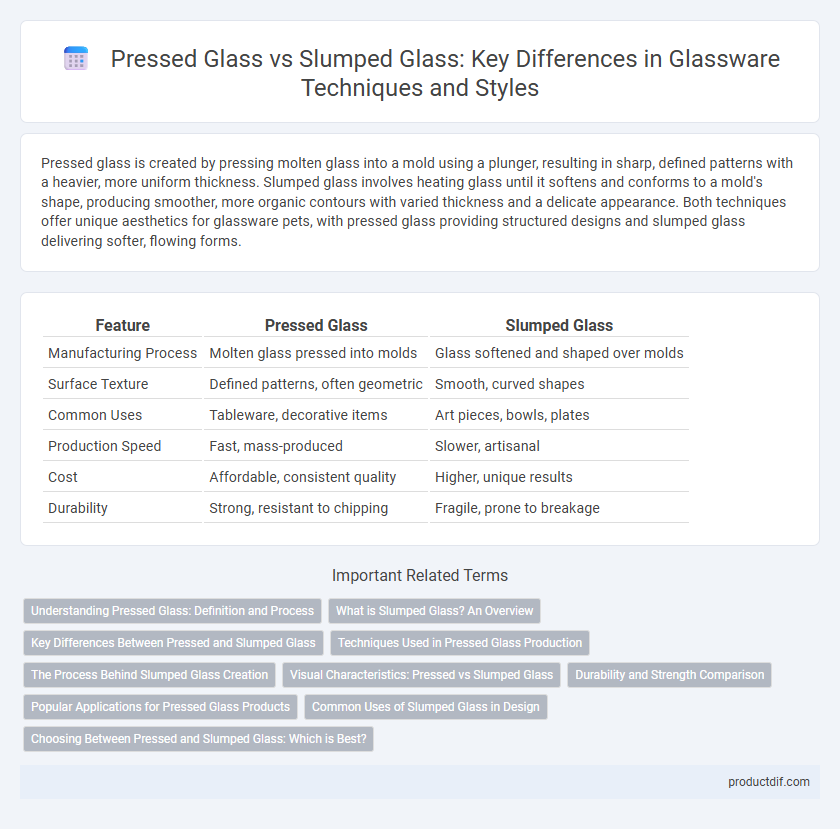Pressed glass is created by pressing molten glass into a mold using a plunger, resulting in sharp, defined patterns with a heavier, more uniform thickness. Slumped glass involves heating glass until it softens and conforms to a mold's shape, producing smoother, more organic contours with varied thickness and a delicate appearance. Both techniques offer unique aesthetics for glassware pets, with pressed glass providing structured designs and slumped glass delivering softer, flowing forms.
Table of Comparison
| Feature | Pressed Glass | Slumped Glass |
|---|---|---|
| Manufacturing Process | Molten glass pressed into molds | Glass softened and shaped over molds |
| Surface Texture | Defined patterns, often geometric | Smooth, curved shapes |
| Common Uses | Tableware, decorative items | Art pieces, bowls, plates |
| Production Speed | Fast, mass-produced | Slower, artisanal |
| Cost | Affordable, consistent quality | Higher, unique results |
| Durability | Strong, resistant to chipping | Fragile, prone to breakage |
Understanding Pressed Glass: Definition and Process
Pressed glass is a type of glassware created by pressing molten glass into a mold using a plunger, allowing intricate patterns and shapes to be formed with high precision. This manufacturing process enables mass production of uniform glass pieces, commonly used for tableware, decorative items, and lighting fixtures. The distinct texture and clarity achieved in pressed glass distinguish it from hand-blown or slumped glass, offering durability and affordability in collectible and everyday glassware.
What is Slumped Glass? An Overview
Slumped glass is a type of glassware formed by heating glass sheets in a kiln until they soften and mold over a pre-shaped mold, creating curved or contoured shapes. Unlike pressed glass, which is molded by pressing molten glass into a mold, slumped glass relies on gravity and heat to take its shape, resulting in unique, handcrafted designs. This technique is popular in decorative art pieces, tableware, and architectural applications due to its versatility and aesthetic appeal.
Key Differences Between Pressed and Slumped Glass
Pressed glass is created by pressing molten glass into molds using a plunger, resulting in intricate patterns and uniform thickness ideal for mass production. Slumped glass involves heating flat glass sheets until they soften and conform to a mold's contours, allowing for more organic shapes and variations in thickness. Key differences include production methods, texture precision, and typical applications, with pressed glass offering detailed designs and slumped glass providing unique, curved forms.
Techniques Used in Pressed Glass Production
Pressed glass production relies on a technique where molten glass is poured into a metal mold and then pressed with a plunger to form intricate patterns and shapes. This method allows for rapid mass production of detailed and uniform glassware with sharp designs and textured surfaces. Compared to slumped glass, which uses heat to shape glass over molds, pressed glass emphasizes mechanical precision through molding and pressing processes.
The Process Behind Slumped Glass Creation
Slumped glass is created by heating a flat glass sheet in a kiln until it becomes soft enough to bend or "slump" over a mold, allowing it to take on the mold's shape without fully melting. This process involves precise temperature control, typically between 1200degF and 1400degF, to ensure the glass maintains its integrity while achieving the desired curvature. Unlike pressed glass, which is molded by pressing molten glass into a pattern, slumped glass relies on gravity and heat to shape the glass into delicate, organic forms.
Visual Characteristics: Pressed vs Slumped Glass
Pressed glass features sharp, well-defined patterns and a uniform thickness due to being formed in molds under high pressure, resulting in a glossy and often ornate appearance. Slumped glass, created by heating glass over molds until it softens and conforms to shapes, exhibits softer, more organic contours and a smoother, sometimes matte surface with less detailed patterning. The visual distinction is marked by pressed glass's crisp, repetitive texture compared to slumped glass's fluid, naturalistic forms.
Durability and Strength Comparison
Pressed glass offers higher durability and strength due to its manufacturing process, where molten glass is mechanically pressed into molds, resulting in a denser and more resilient structure. Slumped glass, shaped by heating flat glass over a mold until it softens and conforms, tends to be more fragile and less impact-resistant because of its thinner, more delicate form. For applications requiring robust, long-lasting glassware, pressed glass is typically the superior choice.
Popular Applications for Pressed Glass Products
Pressed glass is widely used in producing tableware such as plates, bowls, and cups due to its durability and intricate patterns achievable through molds. Its affordability and mass-production capabilities make it popular for decorative items like vases, lampshades, and costume jewelry components. Pressed glass's consistent thickness and design detail are essential for creating collectible glassware and household ornaments.
Common Uses of Slumped Glass in Design
Slumped glass is widely used in architectural and decorative applications, including custom tiles, tabletops, and lighting fixtures, due to its ability to form gentle curves and organic shapes. Designers favor slumped glass for creating textured sinks, backsplashes, and artistic panels that enhance visual interest and dimension. This versatile technique allows for unique, three-dimensional effects that are not achievable with traditional flat or pressed glass.
Choosing Between Pressed and Slumped Glass: Which is Best?
Pressed glass offers precise, consistent patterns created by molding heated glass under high pressure, making it ideal for mass production and durability. Slumped glass involves heating glass to a pliable state and molding it over a shape, providing unique, organic textures best suited for artistic, custom pieces. Choosing between pressed and slumped glass depends on the desired balance of uniformity and artistic expression, with pressed glass favored for functional items and slumped glass for decorative, one-of-a-kind creations.
Pressed glass vs Slumped glass Infographic

 productdif.com
productdif.com